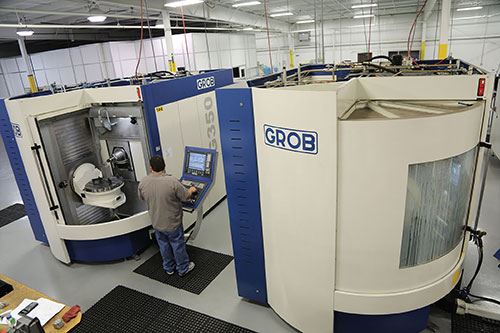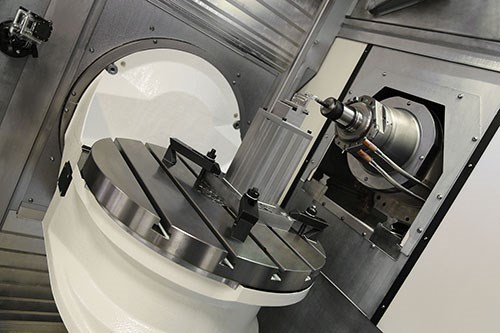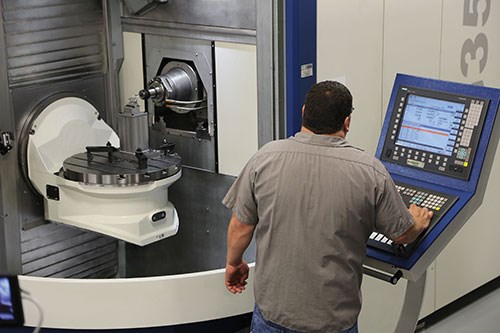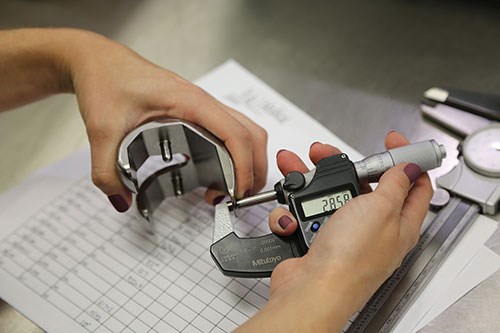Five-Axis HMCs Open Medical Shop Capability
By implementing Grob’s horizontal five-axis machine, B&J Medical was able to make parts quickly and accurately, meeting ISO certification demands for medical manufacturers.
Multi-axis, high speed machining wasn’t new for medical device manufacturer B&J Medical (Kendallville, Indiana). However, the shop’s experience was limited to vertically oriented machines, which the company says posed capability challenges for its medical applications. By investing in five-axis horizontal machines from Grob Systems Inc. (Bluffton, Ohio), the shop was able to improve cycle times and part quality.
B&J Medical was founded in 2010 as a division of 30-year-old custom mold shop B&J Specialty. When customers began approaching the parent company with medical applications, it began to consider this new business opportunity. However, the shop was not equipped to meet the strict ISO 13485-2003 standards to which medical device manufacturers are required to conform. Rather than spend the time, energy and expense necessary to transform the current shop, the company founded B&J Medical.
Complying with ISO standards was no small undertaking, yet B&J Medical was able to achieve both ISO 13485-2003 and ISO 9001-2010 certifications within three months of opening its doors. This was due, in part, to a combination of experienced staff and implementation of Grob’s G350 horizontal five-axis machining centers.
“Our experience in tight-tolerance, five-axis die and mold work made for a natural transition into orthopedic implant and instrument manufacturing,” says Scott Sizemore, VP of operations, and one of the many key staff members who came to B&J Medical from B&J Specialty. “We have several vertical five-axis machines, and are familiar with the programs, controls and tooling necessary for complex parts.”
While B&J Medical had the multi-axis experience necessary to machine a variety of tight-tolerance orthopedic implants and medical instruments, the company recognized that its five-axis vertical machines had certain restrictions. “Vertical machines tend to have a lot of capability limits, require long toolholders; and fixturing can be difficult,” Mr. Sizemore says.
When reviewing options for new machines, the unique design of Grob’s G350 horizontal five-axis machining centers caught Mr. Sizemore’s eye. “The horizontal five-axis design was so much different than what everybody else had,” he says.
B&J Medical’s first Grob G350 was installed in March of 2010. The machine features three linear and two rotary axes, enabling five-sided machining as well as five-axis simultaneous interpolation. The worktable rotates 240 degrees in the A axis and 360 degrees in the B axis to enable complete access to five sides of a part. The ergonomic machine design enables easy access to the table, helping B&J Medical’s team change out parts quickly.
One feature that was immediately beneficial for medical applications was the extremely short tool overhang needed to reach various areas of the part. While extended toolholders are common on the company’s traditional five-axis vertical machining centers, the horizontal orientation of the G350s requires a much shorter reach. The rails and X-type linear roller packs are closer to the part being machined, providing increased rigidity.
“The shorter gage lengths allow us to run at greater feeds and speeds,” Mr. Sizemore says. “This results in noticeably shorter cycle times, often 25 to 30 percent faster than when we ran the same parts on our vertical machines. Keeping the tool closer to the spindle also provides better finished part accuracy.”
While B&J Medical was pleased with the new machine’s accuracy, the shop was hesitant about using its standard-equipped Siemens Sinumerik 840D sl control because it would be the shop’s first experience with a control from the Elk Grove Village, Illinois company. The shop was concerned both that employees would have problems learning the new control, and that it would be challenging to bring existing part programs to the new system.
Mr. Sizemore reached out to CAD CAM Technologies, B&J’s local Mastercam distributor, for help generating a postprocessor for the Siemens controls. According to Mr. Sizemore, after a few tweaks to the postprocessor, they quickly transitioned existing programs over to the new machines. The implementation of the new control was much easier than B&J anticipated, and when the company ordered its second Grob G350 in early 2012, it specified a Siemens control.
Both G350 machines are equipped with Tool Center Point Management (TCP), a feature that wasn’t included in any machine the company previously purchased. With TCP, it is not necessary for the CAM system to know the machine kinematics and tool dimensions. The control is intelligent enough to make all the calculations to take care of the machine kinematics. Designed to reduce setup time and simplify the whole process, the CAM system only needs to know the relationship between the tool tip and the workpiece. TCP also makes it possible to program linear feed rates for five-axis contours on complex surfaces, which improves cycle times and surface quality.
According to Mr. Sizemore, TCP has made his life much easier. “We post nominal numbers, and the Siemens control takes care of the rest.”
Reduced setup time through TCP and improved cycle time thanks to the machines’ horizontal design have enabled B&J Medical to keep up with increased orders. The G350s’ flexibility continues to help the company field the variety of tight-tolerance orthopedic implant and medical instrument machining applications its customers’ demand.
Related Content
Which Approach to Automation Fits Your CNC Machine Tool?
Choosing the right automation to pair with a CNC machine tool cell means weighing various factors, as this fabrication business has learned well.
Read MoreLean Approach to Automated Machine Tending Delivers Quicker Paths to Success
Almost any shop can automate at least some of its production, even in low-volume, high-mix applications. The key to getting started is finding the simplest solutions that fit your requirements. It helps to work with an automation partner that understands your needs.
Read More6 Machine Shop Essentials to Stay Competitive
If you want to streamline production and be competitive in the industry, you will need far more than a standard three-axis CNC mill or two-axis CNC lathe and a few measuring tools.
Read MoreAn Additive Manufacturing Machine Shop
Finish machining additively manufactured implants requires different pacing and workflow than cutting parts from stock — different enough for an experienced manufacturer to warrant a dedicated machine shop.
Read MoreRead Next
The Cut Scene: The Finer Details of Large-Format Machining
Small details and features can have an outsized impact on large parts, such as Barbco’s collapsible utility drill head.
Read More3 Mistakes That Cause CNC Programs to Fail
Despite enhancements to manufacturing technology, there are still issues today that can cause programs to fail. These failures can cause lost time, scrapped parts, damaged machines and even injured operators.
Read More.jpg;maxWidth=970;quality=90)












.jpg;maxWidth=300;quality=90)



.png;maxWidth=300;quality=90)













